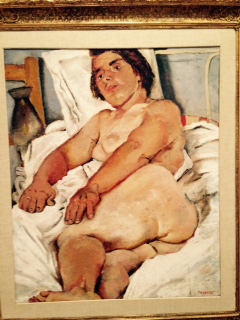AUGUST CHALLENGE DAY 16
For the Silly Season I've set myself the challenge of visiting a different art exhibition on every day of the month and blogging about it.
Sunday August 16
Exhibition: Fausto Pirandello
Place: The Estorick Collection
The children of the famous rarely achieve equivalent success in a different sphere to that of their parent. Fausto Pirandello, son of Italy’s most celebrated playwright, did. He may not have been very well known internationally but in Italy he was regarded as one of their top 20th century painters. This exhibition is a rare chance for London to see why.
Antonio (the artist's son) 1944
It’s a concise survey of a long working life, from the 1920s to the 1960s. Pirandello’s early paintings show his indifference to the stand-out Italian art movements of his time – he owed nothing to the futurists, and little to de Chirico, though he knew him and claimed him as an inspiration. A residence in Paris in the late 1920s brought Pirandello into contact with cubism and surrealism, and these marked his work but only to a limited extent. Back in Rome he associated with other artists of his own generation, who formed a loose Roman school. But for the most part Pirandello went his own way.
 Nude 1928
Nude 1928
He was born in Sicily and I wonder if this is a clue to the general earthiness of many of these paintings. In his female nude studies of the 1920s and 1930s flesh has the colour of red earth, and the body is seen without illusion or idealization. The catalogue claims him as a precursor of Lucien Freud’s vulgarised flesh, but I see these nudes as reflecting the peasant life of Sicily in that period, with its sexual energy and mythological associations. I remember D. H. Lawrence expanding on this in his book Sea and Sardinia.
 Composition1928
Composition1928
Many of Pirandello’s work carry obscure meanings, as if drawing on his unconscious as well as his conscious mind. There are disappearing limbs, items out of time, errant details.
Reversed figure 1953
Pirandello’s post-war painting is brighter. He continued to paint the nude, often in groups of bathers, presumably following Cezanne and Picasso. But Pirandello was really his own man and I hugely enjoyed the energy and quirkiness of his paintings.
Women combing their hair, 1937